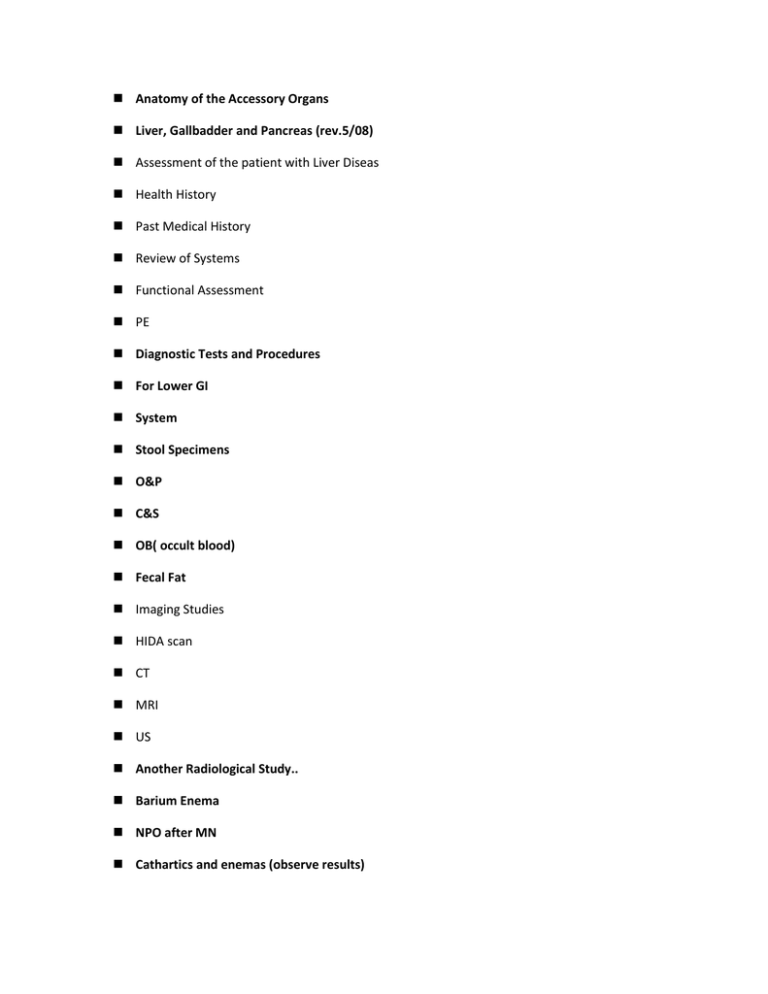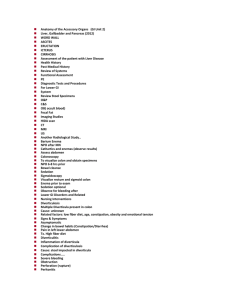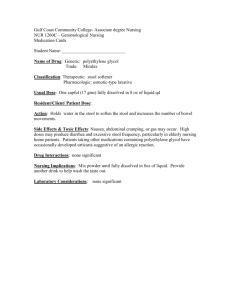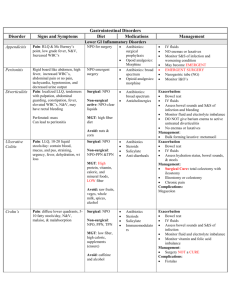Anatomy of the Accessory Organs Liver, Gallbadder and Pancreas
advertisement

Anatomy of the Accessory Organs Liver, Gallbadder and Pancreas (rev.5/08) Assessment of the patient with Liver Diseas Health History Past Medical History Review of Systems Functional Assessment PE Diagnostic Tests and Procedures For Lower GI System Stool Specimens O&P C&S OB( occult blood) Fecal Fat Imaging Studies HIDA scan CT MRI US Another Radiological Study.. Barium Enema NPO after MN Cathartics and enemas (observe results) Assess abdomen Colonoscopy To visualize colon and obtain specimens NPO 6-8 hrs prior Bowel cleanse Sedation Sigmoidoscopy Visualize rectum and sigmoid colon Enema prior to exam Sedation optional Observe for bleeding after Lower GI Disorders and Related Nursing Interventions Diverticulosis Multiple Diverticula present in colon Cause: unknown Related factors: low fiber diet, age, constipation, obesity and emotional tension Signs & Symptoms Asymptomatic Change in bowel habits (Constipation/Diarrhea) Pain in left lower abdomen Tx. High fiber diet Diverticulitis Inflammation of diverticula Complication of diverticulosis Cause: stool impacted in diverticula Complications…. Severe bleeding Obstruction Perforation (rupture) Peritonitis Fistula formation Medical Treatment Bedrest NPO and IV Fluids GI decompression Analgesics ABX Surgical Treatment Colon resection Colostomy Colostomy Surgical opening between the colon and the surface of the body; creation of a stoma Named for the part of colon where located Temporary or Permanent Ostomy Care Assess: Stoma color Q shift Bowel function Bowel sounds, distention, tenderness Clean w/ H20, cover w/ ointment or paste (see pg. 407) Abdominal Hernia Muscle weakness resulting in intestine protruding through muscle Reducible Irreducible or incarcerated Incarcerated hernias have obstructed peristaltic flow Strangulated hernia is deprived of blood flow Types of Hernias Inguinal Femoral Umbilical Incisional Cause… Congenital Acquired Signs & Symptoms Vary depending on location Some are asymptomatic Strangulated is a emergency Surgical Treatment Herniorrhaphy Hernioplasty Truss Post Op Nursing Interventions Assess bowel and bladder function Assess wound healing Teach to avoid stress on healing wound Intestinal Obstruction Adhesions Strangulated hernia Tumor Volvulus Intussuseption Signs & Symptoms Abdominal pain N/V ( possible projectile) Constipation Bloating Medical Treatment NGT for decompression IV hydration Surgery may be needed Medications… Non-narcotic analgesics Antibiotics THINK…. What are 3 nursing diagnosis and related nursing interventions for the patient with an intestinal obstruction??? Irritable Bowel Syndrome AKA Spastic colon, spastic colitis, mucus colitis, irritable colon Most common GI complaint Unknown cause Signs & Symptoms Abdominal pain Cramping Flatulence Constipation/Diarrhea Diagnostic Tests UGI BE Sigmoidoscopy Treatment Reduce stress Counseling High fiber diet/Metamucil Lifestyle changes Adeq. Fluids & regular meal patterns Medications Sedatives Anti-spasmodic Anti-diarrheal Constipation Infrequent, hard, dry stools Tumors Frequent laxative use Inactivity low Fluid intake & low fiber diet Treatment Fiber supplements Laxatives Stool softeners Or a combination of above Nursing Interventions Teach patient to Increase… Fiber Fluids Activity Diarrhea Loose stools with increased frequency S/S pain, abdominal cramps, urgency, flatus Complications…. Dehydration Electrolyte imbalances Metabolic acidosis Malabsorption leading to malnutrition and anemia Nursing Interventions NPO, IV, TPN if severe sx I&O, daily weight Record T-A-C of stool Motility reducers Monitor electrolytes Inflammatory Bowel Disease ( IBD ) Crohn’s Disease Ulcerative Colitis Unknown cause ? Autoimmune reactions tx with steroids Crohn’s Disease Lesions affect the entire thickness of bowel; can occur anywhere in the colon or small intestine Signs & Symptoms Variable depending upon areas affected N/V & epigastric pain Abdominal pain, tenderness and cramping Rectal bleeding & diarrhea S/S ( cont’d) Weight loss Steatorrhea Electrolyte imbalance Iron deficiency anemia Amino acid mal-absorption Long Term Complications Hemorrhage Bowel obstruction Fistulas Abscesses Perforation(rupture) Ulcerative Colitis Inflammation & ulceration of the mucous membrane in colon S/S: Fever, anorexia, wt. loss Frequent, watery stools with mucous & blood Long Term Complications Fissures Abscesses Increased risk of colon CA Toxic megacolon Diagnostic Tests IBD BE w/ small Bowel follow- through Colonoscopy w/ biopsy Ultrasound CAT Med/Surg. Management Control inflammation steroids Relieve symptoms Maintain fluid and electrolytes Provide adequate nutrition Prevent complications Limit milk products High cal, low residue, non-spicy, caffeine free diet Surgical Intervention Colectomy curative for ulcerative colitis NOT for Crohn’s disease Medications used alone or in combination…. Corticosteroids Immunosupressants Antidiarrheals Anticholinergics Antibiotics and others… Appendicitis Inflammation of the appendix If ruptured peritonitis develops which may be fatal Signs & Symptoms Pain at McBurney’s Point N/V Fever Rebound tenderness Treatment Appendectomy Pre-op Orders: NPO IV fluids Appendectomy Post-op Orders NPO until BS return then advance diet as tolerated V.S., TC & DB Assess wound for s/s infection OOB ASAP Peritonitis Inflammation of peritoneum Contamination of the peritoneal cavity Abscesses, septicemia, hypovolemic shock, paralytic ileus and organ failure. Signs & Symptoms Pain over affected area Fever Tachycardia N/V Tachypnea S/S (cont’d ) Distended, board-like abdomen ( rigidity ) Paralytic ileus Treatment Surgery to repair cause Abdominal cavity irrigation with NS and abx soln IV abx. Nursing Interventions NPO w/ NGT IV fluids Monitor drains Elevate HOB For abd. Distention and BS V.S. Activity as tolerated C&DB Analgesics Colorectal CA 3rd most common CA in women Risk factors: Over 45 Hx of polyps Hx of IBD Signs & Symptoms Change in bowel habits Wt loss Abd cramping Rectal bleeding Diagnostic Tests Colonoscopy BE CEA CBC Surgical Treatment Polypectomy Colon resection Chemo Radiation Post Op Nursing Care NPO w/ NGT C&DB Early ambulation Assess wound for infection Opioid analgesics Hemorrhoids Varicosed veins of rectum Internal or external Risk factor: Increased intra-abd pressure Signs & Symptoms Painful Puritis Bleeding Non surgical treatment Sitz baths Warm compresses or ice packs Stool softeners Creams Surgical Treatment Ligation Sclerotherapy Thermocoagulation Laser surgery hemorrhoidectomy Post op Nursing Interventions Pain control Assess for rectal bleeding, keep area clean Monitor stools passed after surgery, provide stool softeners VS Ambulate Anorectal Abscess Infection of tissue around the anus What are s/s…..? Treatment…? I&D Anal Fissure Laceration between the anal canal and perianal skin Usually heal spontaneously Anal Fistula Abnormal opening between anal canal and perianal skin S/S pruritus and discharge TX sitz baths, excision of fistula & surrounding skin Temporary colostomy PRN Pilonidal Cyst Cyst in sacrococcygeal area Easily infected Usually requires surgical excision Care similar to hemorrhoidectomy Disorders of the Accessory Organs Gallbladder, Pancreas and Liver Diagnostic Tests CT Liver Scan Ultrasonography MRI Biopsy ( liver, needle, open) ERCP Lab Tests PT, PTT, INR Bilirubin Serum protein Alk. Phosphatase AST, ALT,LDH Cirrhosis of the Liver Chronic, progressive disease of the liver 40-60 yrs. highest incidence Related to alcoholic liver disease or chronic viral infection Signs & Symptoms Early weight loss, fever, fatigue, heaviness in rt. Upper abdomem Progimpaired metabolism, GI disturbances, congestion of bloodflow causes ^ pressure of intestines, stomach, esophag. Later signs and symptoms… Jaundice Ascites Abd pain Peripheral neuropathy Dyspnea Bleeding disorders Dry puritic skin Confusion Clay colored stool Complications… Portal hypertension Esophageal varices Ascites Hepatic encephalopathy Esophageal Varices Distended esophageal blood vessels Caused by ^ pressure in portal system Bleed easily TX for Bleeding Varices Drug therapy Surgical ligation Esophageal – gastric balloon Sclerotherapy TX for Ascites Na+ restriction diet and diuretics Paracentesis Shunts Hepatic Encephalopathy Liver unable to detoxify ammonia Reduce ammonia by restricting protein Lactulose binds with ammonia causes diarrhea Asterixis- most common sign Nursing Care for the patient with Cirrhosis Emollient baths( oatmeal or baking soda ) Blood transfusions Low Na, high vitamin diet Small frequent meals Nrsg Care (cont’d) No ETOH Diuretics Vitamin K Daily weight Abd. girth measurements THINK…. What are 3 nursing diagnosis and related nursing interventions when caring for the patient with cirrhosis of the liver??/ Liver Transplantation Only cure for end stage liver disease Patients ranked by acuity and need Nursing assessments focus on: neuro status, VS, respiratory status, and indicators of bleeding. Provide usual post op care Lifelong drug therapy is needed Hepatitis Inflammation & swelling of the liver Bile channels are compressed Blood flow through liver is impaired Signs & Symptoms Fatigue / lethargy Nausea Abd pain Joint and muscle aches Decreased appetite S/S ( cont’d) Jaundice Hepatomegaly Dark urine Puritis Treatment Goal… To promote healing and manage symptoms Allow liver to regenerate Prevent transmission Medications Alphainterferon Ribavirin Antipyretics Antiemetics Avoid hepatotoxic drugs Dietary Changes High cal, high carb, high pro Low fat Vitamin supplements No ETOH Liver Cancer Primary site rare Frequent site metastasis Signs & Symptoms Liver enlargement Weight loss Anorexia / N&V URQ pain Treatments Lobectomy Chemo Radiation Gallbladder Disease Cholecystitis - inflammation of gallbladder Cholelithiasis – gallstones 5 F’s Diagnostic Tests US ERCP Cholangiography Signs & Symptoms RUQ pain 2-4 hours after meals N/V Flatulence Indigestion, belching S/S ( cont’d) Steatorrhea Clay colored stools Increased WBC, serum and urinary bilirubin and enzymes Medical Treatment Low fat diet Demerol ABX UDCA, and MTBE Surgical Treatment Endoscopic Sphincterotomy Extracorporeal Shock Wave Lithotripsy Cholecystectomy Post Op Nursing Care T, C, & DB NGT Monitor T-tube IV’s Incentive spirometer Common Bile Duct Obstruction Stones block bile flow within common bile duct Signs & Symptoms Intense spasmotic pain (biliary colic) Fever Jaundice ^ WBC, ^enzymes Treatment ERCP with sphincterotomy to enlarge opening and facilitate passage of stone Nursing Care VS IV hydration ABX Analgesics Monitor lab results Pancreatitis Inflammation of the pancreas May be acute or chronic Causes: Backflow of bile into the pancreas Gallstone or tumor ETOH Trauma Signs & Symptoms Severe, sudden onset abdominal pain in ULQ Vomiting Flushing Fever S/S (cont’d) Tachypnea Tachycardia Tender, distended abdomen Bowel sounds may be absent Elevated serum amylase Medical Management Pain control Demerol Anticholinergics, Antispasmodics Assess for new onset DM Antacids Pancrease to reduce steatorrhea Nursing Care NGT NPO IV TPN (in severe cases) No caffeine or ETOH No spicy foods High carb, high pro. Low fat/Low Na+ Small frequent meals Pancreatic Cancer Tumors usually malignant Prognosis poor Metastasizes quickly Most die within 1 yr of diagnosis Signs & Symptoms Pain Jaundice Weight loss Glucose intolerance Surgical Procedures See page 831 Figure 39-13 Most often procedures preformed are Side-to-side and the Whipple Nursing Care PCA for pain control Monitor I & O VS Monitor blood glucose Emollient lotions/Benadryl You’re done with GI Unit 2….. YIPPEEE !!!!






